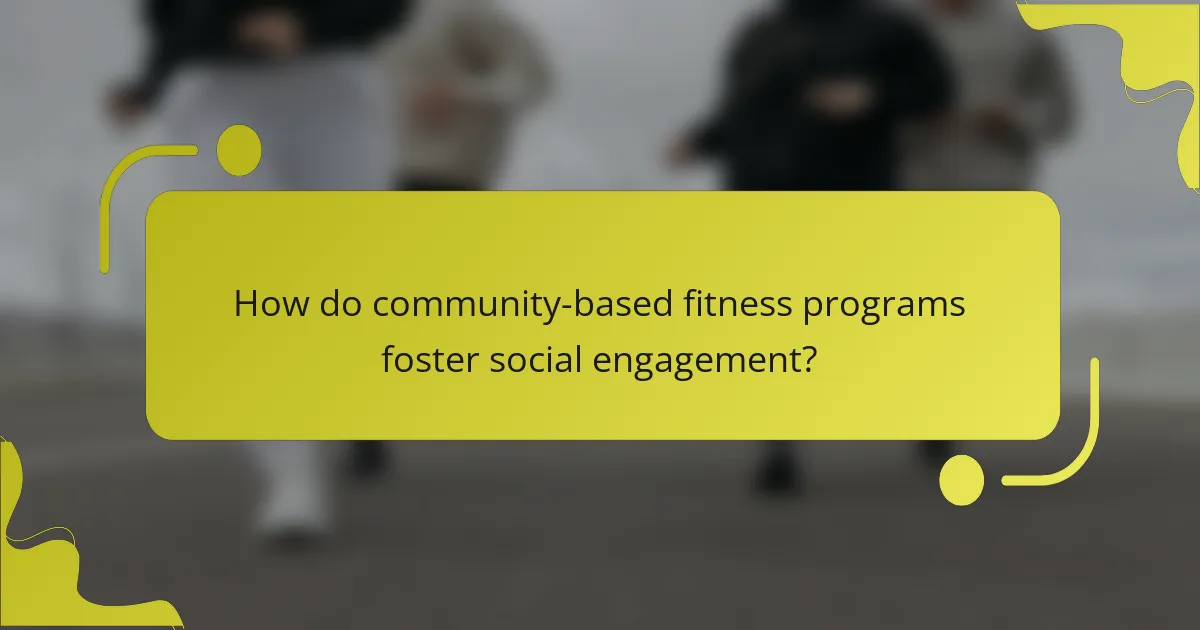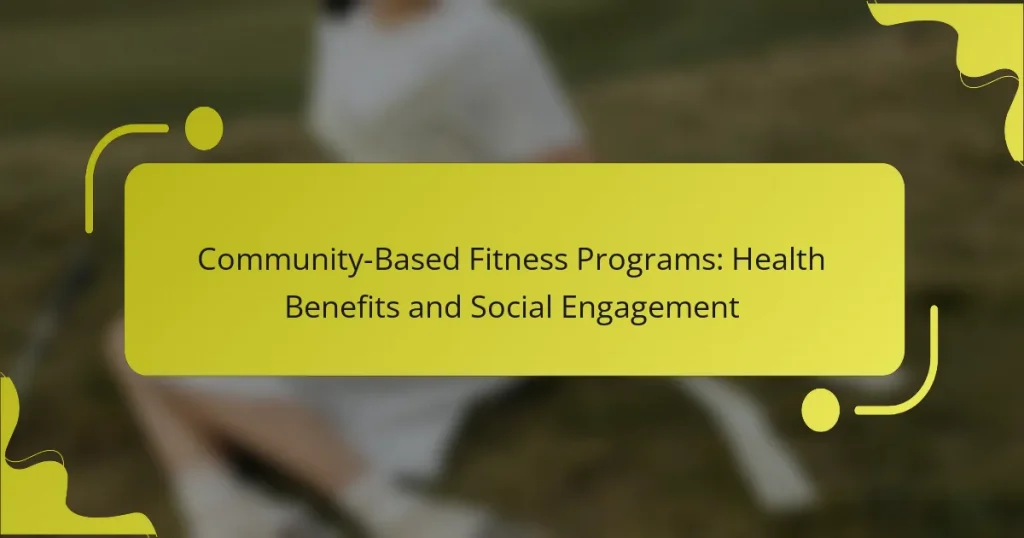Community-based fitness programs improve physical health and mental well-being while fostering social connections. They offer diverse activities that cater to various fitness levels, enhancing community engagement. However, challenges like funding and accessibility can impact their effectiveness. Successful programs prioritise inclusivity and adapt to community needs to promote sustained participation.

What are the key health benefits of community-based fitness programs?
Community-based fitness programs offer numerous health benefits, including improved physical fitness, enhanced mental well-being, and increased social support. Participants often experience better cardiovascular health, weight management, and reduced stress levels. Social engagement fosters a sense of belonging, which can lead to increased motivation and adherence to fitness routines. Additionally, these programs often provide access to diverse activities, catering to various fitness levels and preferences, promoting overall wellness.
How do these programs enhance physical health?
Community-based fitness programs significantly enhance physical health by promoting regular exercise and social interaction. These programs often provide structured activities, which can lead to improved cardiovascular fitness and muscle strength. Participants benefit from the motivation and accountability that come from group settings, encouraging consistent attendance and engagement. Additionally, social connections formed within these programs can reduce stress and improve mental well-being, further contributing to overall health. Studies show that individuals involved in community fitness initiatives report higher levels of physical activity and better health outcomes compared to those who exercise alone.
What mental health improvements can be gained?
Community-based fitness programs can significantly enhance mental health by fostering social connections and reducing feelings of isolation. Participants often experience improved mood, increased self-esteem, and reduced anxiety levels. Engaging in group activities also promotes a sense of belonging, which is crucial for mental well-being. Research indicates that regular participation in these programs can lead to a 20% reduction in depressive symptoms.
Which social benefits are associated with participation?
Participation in community-based fitness programs fosters social connections, enhances mental well-being, and promotes a sense of belonging. Engaging in these programs often leads to increased social interactions, which can reduce feelings of isolation. Additionally, participants report improved self-esteem and motivation through shared goals and experiences. These social benefits contribute to a healthier community overall.

How do community-based fitness programs foster social engagement?
Community-based fitness programs foster social engagement by creating supportive environments that encourage interaction and teamwork. Participants often form friendships, enhancing their sense of belonging. These programs typically include group activities, which promote communication and collaboration, strengthening community ties. Studies show that social connections formed in fitness settings can lead to improved mental health and increased motivation to maintain an active lifestyle.
What role does group motivation play in these programs?
Group motivation significantly enhances community-based fitness programs by fostering accountability and camaraderie among participants. This social support encourages consistent attendance and participation, leading to improved health outcomes. Research shows that individuals are more likely to commit to fitness goals when they feel connected to a group, as shared experiences create a sense of belonging. Additionally, group motivation can amplify individual performance, pushing members to challenge themselves beyond personal limits. Overall, the collective energy and encouragement within these programs drive sustained engagement and positive lifestyle changes.
How do local events promote community interaction?
Local events enhance community interaction by fostering social connections and promoting active lifestyles. Community-based fitness programs serve as a platform for individuals to engage with one another while improving their health. These programs often include group workouts, sports leagues, and wellness workshops, which encourage collaboration and camaraderie among participants.
Research indicates that social engagement through fitness activities can lead to increased motivation and adherence to exercise routines. For example, individuals participating in group fitness classes report higher levels of enjoyment and commitment compared to solo workouts. Additionally, these programs can help build a sense of belonging, as members share common goals and experiences.
Moreover, local events that incorporate fitness challenges or health fairs can attract diverse community members, creating opportunities for networking and support. By bringing people together in a positive environment, these events strengthen community ties and promote a culture of health and wellness.
Which demographics are most engaged in these programs?
Individuals aged 25 to 45 are most engaged in community-based fitness programs. This demographic often seeks health benefits and social interaction. Programs attract diverse groups, but young professionals and parents show significant participation. Moreover, studies indicate that women tend to engage more than men in these community settings, fostering supportive environments.

What unique formats exist within community-based fitness programs?
Community-based fitness programs offer unique formats such as group classes, outdoor boot camps, and virtual meetups. These formats enhance social engagement while promoting physical health.
Group classes foster community spirit through shared experiences and motivation. Outdoor boot camps utilise natural environments for dynamic workouts, encouraging teamwork. Virtual meetups expand accessibility, allowing participation from diverse locations. Each format emphasises community interaction, enhancing overall fitness experiences.
How do outdoor fitness classes differ from indoor ones?
Outdoor fitness classes foster greater social engagement and community interaction compared to indoor classes. Outdoor settings often enhance motivation and enjoyment through natural surroundings. Participants may experience increased physical and mental health benefits due to exposure to fresh air and sunlight. Additionally, outdoor classes typically offer more varied environments, which can lead to unique workout experiences.
What are the benefits of specialized programs for seniors?
Community-based fitness programs offer seniors numerous health benefits and enhance social engagement. These programs improve physical fitness, reduce the risk of chronic diseases, and foster a sense of community among participants.
Regular participation in these programs can lead to increased strength, balance, and flexibility, which are crucial for maintaining independence. Additionally, social interactions within these settings combat loneliness and improve mental health, contributing to overall well-being.
Research shows that seniors engaged in community fitness activities experience lower rates of depression and anxiety. As a result, they report higher satisfaction with life and better emotional resilience.
In summary, community-based fitness programs significantly enhance both physical health and social connections for seniors, making them a valuable resource for aging populations.
Which community partnerships enhance program offerings?
Community partnerships significantly enhance community-based fitness programs by providing resources, expertise, and outreach opportunities. Collaborations with local health organizations, schools, and businesses can increase participation and improve program effectiveness.
For example, partnerships with healthcare providers can offer health screenings and wellness education. Collaborating with schools allows access to facilities and youth engagement, while local businesses can sponsor events or provide incentives for participants. These partnerships not only expand the reach of fitness programs but also foster a sense of community and social engagement among participants.

What challenges do community-based fitness programs face?
Community-based fitness programs face challenges such as limited funding, participant retention, and varying levels of community support. These factors can hinder their effectiveness and sustainability. Additionally, programs may struggle with accessibility, especially in underserved areas, which can limit participation and engagement. Social dynamics, like differing fitness levels and motivations among participants, can also create barriers to group cohesion and success.
How do funding issues impact program sustainability?
Funding issues significantly hinder the sustainability of community-based fitness programs. Limited financial resources restrict operational capacity, reducing access to necessary facilities and equipment. Programs may struggle to attract and retain qualified staff, impacting service quality. Additionally, inconsistent funding affects outreach efforts, diminishing community engagement and participation. As a result, the overall health benefits and social cohesion intended by these programs may not be realised, ultimately threatening their longevity.
What barriers exist for participant engagement?
Barriers to participant engagement in community-based fitness programs include lack of access, time constraints, and social stigma. These factors can deter individuals from joining programs that promote health benefits and social interaction.
Access issues often arise from inadequate facilities or transportation options. Time constraints can stem from busy schedules, making it difficult for individuals to commit. Social stigma may prevent some community members from participating due to perceived judgment or lack of inclusivity.
Addressing these barriers is crucial for enhancing participation and maximising the positive impacts of community-based fitness initiatives.
How do cultural differences affect program design?
Cultural differences significantly influence program design by shaping community engagement and preferences. Understanding these differences ensures that community-based fitness programs are relevant and effective.
Programs must consider cultural values, social norms, and local traditions to enhance participation. For example, fitness activities may need to align with community events or holidays. Programs that respect and incorporate local customs tend to foster higher social engagement.
Moreover, language barriers can affect communication and outreach strategies. Providing materials in multiple languages or using culturally relevant imagery can improve accessibility and inclusivity.
Finally, recognising unique attributes of various cultures, such as dietary practices or traditional forms of exercise, can inform program offerings. Tailoring fitness programs to meet these cultural needs enhances their overall impact on health and community cohesion.

What are the best practices for implementing successful community-based fitness programs?
Successful community-based fitness programs prioritise inclusivity, engagement, and sustainability. Key practices include fostering a welcoming environment, offering diverse activities, and building partnerships with local organizations.
1. Assess community needs through surveys and focus groups to tailor programs.
2. Promote social interaction by organizing group activities and events.
3. Ensure accessibility by providing options for various fitness levels and abilities.
4. Utilise local resources, such as parks and recreation centres, to enhance program visibility and participation.
5. Measure success through participant feedback and health outcomes to refine offerings.
How can programs effectively measure success?
Community-based fitness programs can measure success through participant engagement, health outcomes, and community impact. Tracking attendance rates and retention helps assess engagement levels. Health outcomes can be evaluated using metrics like weight loss, improved fitness levels, and reduced chronic disease markers. Community impact may include increased social cohesion and reduced healthcare costs. Regular surveys and feedback mechanisms provide qualitative insights into participant satisfaction and program effectiveness.
What strategies improve participant retention?
Engaging participants through community-based fitness programs enhances retention significantly. Strategies include fostering social connections, offering diverse activities, and providing personalised support.
Social connections create a sense of belonging, encouraging participants to return. Diverse activities cater to varying interests, maintaining engagement. Personalised support addresses individual goals, enhancing motivation and commitment.
Implementing feedback mechanisms allows participants to voice their preferences, ensuring programs evolve to meet their needs. Regular community events strengthen bonds and promote a supportive environment.
Incorporating educational components about health benefits reinforces the value of participation, motivating individuals to stay active in the program.
Which outreach methods are most effective in diverse communities?
Community-based fitness programs effectively engage diverse communities through personalised outreach, culturally relevant activities, and partnerships with local organizations. These methods foster trust and enhance participation. For instance, tailored communication strategies, such as multilingual materials, ensure inclusivity. Additionally, incorporating community leaders can amplify credibility and encourage involvement. Social events that celebrate local culture further strengthen community ties and promote health benefits.
What common mistakes should be avoided when starting a program?
Common mistakes to avoid when starting community-based fitness programs include lack of clear goals, inadequate community engagement, ignoring diverse needs, and insufficient promotion. Establishing specific objectives ensures focus and direction. Engaging the community fosters ownership and participation. Addressing diverse needs enhances inclusivity and effectiveness. Promoting the program builds awareness and attracts participants.




